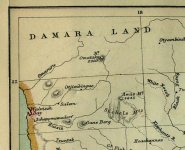Björn Bergenholtz
(former alias "Calalp")

1944 Falco peregrinus wallichensis Bradfield
●Bradfield, R. D. 1944. New South African ornithological records (pamphlet).
Martin, Great job finding that one!
For Walfish Bay (a k a Whale Bay) which was changed to Walvish Bay alt. Walwich Bay or Walwisch Bay, the latter versions from the Dutch Walvisch Baye (all referring to today's Walvis Bay, in Namibia) ...? If so I guess the name is coined after the Bay itself, not the town with the same name, located on its shores.
It´s Walfischbucht or Walfischbai in German.
See, for example; here, here and here (map of 1885, upper left corner, excerpt attached)
---
●Bradfield, R. D. 1944. New South African ornithological records (pamphlet).
Martin, Great job finding that one!
Yet another typo!? :eek!:The name is that given by the British sailors to the bay when mapping and sign beaconing the West coast. This name was changed by the Germans.
For Walfish Bay (a k a Whale Bay) which was changed to Walvish Bay alt. Walwich Bay or Walwisch Bay, the latter versions from the Dutch Walvisch Baye (all referring to today's Walvis Bay, in Namibia) ...? If so I guess the name is coined after the Bay itself, not the town with the same name, located on its shores.
It´s Walfischbucht or Walfischbai in German.
See, for example; here, here and here (map of 1885, upper left corner, excerpt attached)
---
Attachments
Last edited:




